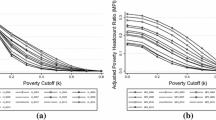Abstract
This paper contests the major emphasis placed on the multidimensional nature of poverty measurement. Instead, it argues that poverty pictures created by different measures and at different units of analysis tend to converge. This argument is derived from a comparison of poverty pictures created using income and asset-based measures at the national and household level in five South African Development Community countries. Although multidimensional measures have value in illuminating subtle differences, the findings indicate a single dimension of poverty that runs throughout all the measures and levels of analysis. However, despite the single poverty picture provided by different measures, the abandonment of these different measures is not supported. Multidimensional measures provide insight into particular elements of poverty that is useful and relevant to poverty interventions.

Similar content being viewed by others
References
Appleton, S., & Song, L. (1999). Income and human development at the household level: Evidence from six countries. Oxford, UK: University of Oxford: Centre for the Study of African Economies.
Bhorat, H. (1999). Distinguishing between individual- and household-level poverty. Development Southern Africa, 16, 157–162.
Bourguigon, F. (2002). Multi-dimensional poverty orderings (Working Paper of DELTA No. 22). Paris: Delta.
Dercon, S. (2005). Poverty measurement. In D. A. Clark (Ed.), The Elgar companion to development studies. Cheltenham: Edward Elgar Publishing.
DFID. (2001). Poverty: Bridging the gap. London: DFID.
Diaz, G. (2003). Multidimensional poverty. Paper presented at the Wider conference on inequality, poverty and human well-being, Helsinki.
Duclos, J. Y., Sahn, D., & Younger, S. (2006). Making multidimensional poverty comparisons. The Economic Journal, 116, 943–968.
Duclos, J., Sahn, D. E., & Younger, S. (2001). Robust multidimensional poverty comparisons. Cornell Food and Nutrition Working Paper No. 98. Ithaca, NY: Cornell University.
Haupt, P. (2006). The SAARF universal living standards measure (SU-LSM): 12 years of continuous development. Available at http://www.saarf.co.za/.
Haupt, P. (2002). LSMs: Twelve years of continuous development. Paper presented at the Annual Research, Pretoria.
Iceland, J. (2003). Poverty estimates using alternative units of analysis. Paper presented at the National Institutes for Child Health and Human Development, Measurement Issues in Family Demography Conference, Washington DC.
Kakwani, N. (1984). Issues in measuring poverty. Advances in Econometrics, 3, 253–282.
Laderchi, C. R. (1997). Poverty and its many dimensions: The role of income as an indicator. Oxford Development Studies, 25, 345–360.
Mattes, R., Bratton, M., & Davids, Y. D. (2003). Poverty survival and democracy in Southern Africa Afrobarometer (Working Paper No. 23). Cape Town: Idasa.
Sahn, D. E. & Stifel, D. C. (2000). Poverty comparisons over time and across countries in Africa. World Development, 28, 2123–2155.
Sahn, D. E., Stifel, D., & Younger, S. (1999). Inter-temporal changes in welfare: Preliminary results from nine African countries. Cornell Food and Nutrition Policy Program (Working Paper No 94). Ithaca, NY: Cornell University.
Scott, L. (2002). A poverty indictor system for local government. Development Southern Africa, 19, 483–501.
Sen, A. K. (1976) Poverty: An ordinal approach to measurement. Econometrica, 44, 219–231.
Shimeles, A., & Thoenen, R. (2005). Poverty profiles: A methodological note on measuring poverty (Working Paper of the economic and social policy division). New York: United Nations.
South African Advertising Research Foundation. (2001). Living standards measure. Retrieved July 19, 2005, from http://saarf.co.za/lsms.htm.
The World Bank. (1990). World development report 1990. New York: Oxford University Press.
The World Bank. (2001). World development report 2000/2001: Attacking poverty. New York: Oxford University Press.
Townsend, P. (1979). Poverty in the United Kingdom. Harmondsworth: Penguin Books.
Tsui, K. (2002). Multidimensional poverty indices. Social Choice and Welfare, 19, 69–93.
UNESCAP. (1999). Poverty measurement in transition countries: A case of Mongolia. Paper presented at the working group of statistical experts, 11th session, Bangkok.
UNICEF. (2005). The state of the world’s children. New York: Author. Retrieved June 12, 2005, from http://www.unicef.org/sowc05/english/.
United Nations. (2000). Programme of action of the World Summit for Social Development. Retrieved June 12, 2005, from http://www.un.org/esa/socdev/wssd/agreements/poach2.htm.
United Nations Development Programme (UNDP). (1994). Human development report: New dimensions of human security. Oxford: Oxford University Press.
United Nations Development Programme. (2005). Human development report 2005. New York: Author.
Wagle, U. (2005). Multidimensional poverty measurement with economic well-being, capability, and social inclusion: A case from Kathmandu, Nepal. Journal of Human Development, 6, 301–328.
Acknowledgements
We would like to thank the HSRC, and especially Dr. Stephen Rule, for making this data available to us for secondary analysis. The second author also acknowledges financial support from the Oppenheimer Foundation and the NRF, which made his participation in the research possible.
Author information
Authors and Affiliations
Corresponding author
Rights and permissions
About this article
Cite this article
von Maltzahn, R., Durrheim, K. Is poverty multidimensional? A comparison of income and asset based measures in five Southern African countries.. Soc Indic Res 86, 149–162 (2008). https://doi.org/10.1007/s11205-007-9105-7
Received:
Accepted:
Published:
Issue Date:
DOI: https://doi.org/10.1007/s11205-007-9105-7




